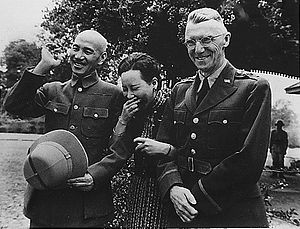Several scholars have recently begun a conversation about why the history of China’s contribution to World War II has fallen out of the mainstream American historical conversation. The Second Sino-Japanese War was immensely destructive, served to set the stage for the Pacific War, but has received comparatively little attention relative to the other main theaters of conflict in World War II. Deflecting the historiographical question for a moment, why have so few American filmmakers tackled such a potentially rich topic?
The simple, straightforward answer is this: Americans do not make many movies about World War II that do not prominently feature Americans. World War II’s Eastern Front has a few entries: Enemy at the Gates, a 2001 film about the Battle of Stalingrad, took advantage of the wake of Saving Private Ryan to earn back its budget and a bit more. 1977’s Cross of Iron (a British-German production directed by American Sam Peckinpah) depicted the German side of the conflict. Defiance, a 2008 film about Jewish partisan activity in Belarus, straddled the border between war movie and Holocaust film.
But the China Theater differs a bit, because individual Americans did play prominent roles in the conflict. General Joseph Stilwell starred, so to speak, in Barbara Tuchman’s popular Stilwell and the American Experience in China. The equally colorful General Claire Chennault led the American Volunteer Group (Flying Tigers) and later the US Army Air Force’s Fourteenth Air Force. During the war, these figures regularly appeared in the pages of Time magazine and other publications, keeping the Sino-Japanese theater alive for American readers. One of Frank Capra’s seven Why We Fight films covered China’s struggle. More recently, other elements of the Sino-Japanese conflict have also found their way into American pop culture. The late Iris Chang’s The Rape of Nanking achieved huge success in the United States.
But the closest we have to a recent American movie about the war is Stephen Spielberg’s 1987 film, Empire of the Sun. That film traces the experiences of a British boy in the Shanghai Concession, and later in an internment camp. The most important reason for the sudden decline in American interest in the Sino-Japanese conflict may lie in the dramatic political about face in East Asia in 1949. Within a very short period of time, China’s heroic defenders were driven into the sea by hostile communists, just as Japan began its long march to reintegration into the community of nations. Films that depicted Japanese depredations against China became very difficult to make.
With that in mind, the time may have come for a biopic about Joseph Stilwell, or an action film depicting the experiences of the Flying Tigers. U.S. studios have greater access to Chinese acting talent (not to mention locations) than ever before, and a film about the joint U.S.-Chinese war effort might enjoy success on both sides of the Pacific.

































